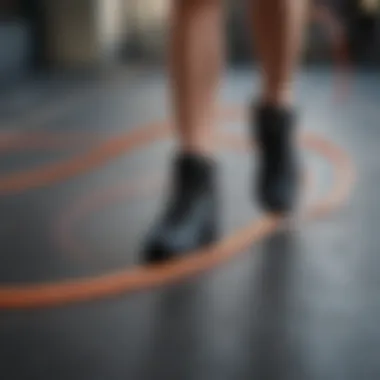Discover the Diverse Health Benefits of Jump Rope Fitness


Intro
Jumping rope is often seen as a simple child's game, yet dismissing it as such overlooks its profound advantages as a serious fitness tool. This activity blends cardiovascular conditioning with muscular engagement, presenting an effective exercise choice for various fitness levels. Whether you are a busy parent, a student, or a professional, the portability and simplicity of a jump rope mean that it can fit seamlessly into even the most active lifestyles.
The upcoming sections will break down in detail the unique elements that make jump rope exceptionally valuable. By focusing on its myriad health benefits, along with practical insights on how to incorporate jump roping into daily routines, this discussion aims to enhance your fitness journey.
Time Management Techniques
While the physical benefits of jumping rope are well-documented, understanding how to approach the activity effectively in a busy schedule is essential. Time management techniques can help integrate jump rope into your routine successfully.
Prioritization Methods
Establish clear priorities when deciding how to include jump rope in your day. Ask yourself:- What fitness goals do you wish to achieve?
- Are there specific times that are more convenient for your routine?
- Do you have particular days of the week designated for workouts?
Focusing on these factors allows you to prioritize your exercise sessions effectively, enabling you to benefit from the positive impacts of consistent jump rope usage.
Task Scheduling Strategies
Allocating dedicated times for exercise increases your accountability. Try the following strategies:
- Set time blocks: Schedule fitness time in your calendar like any important meeting.
- Incorporate varied intensities: Mix jump rope sessions with other workouts for holistic fitness approaches.
A regular routine lowers the chance of skipping workouts and makes your fitness endeavor feel more habitual.
Procrastination Prevention Tips
Procrastination can diminish motivation. Here are ways to combat this:
- Visual reminders: Keeping the jump rope visible serves as a prompt to engage.
- Accountability partners: Encourage a friend or family member to join you. The social aspect can drive consistency.
Personal Development Insights
Jumping rope not only strengthens the body but also promotes personal growth through goal-setting and mindfulness practices.
Goal Setting and Achievement
Define set, achievable short-term and long-term fitness goals. For instance, begin with jumping at a consistent pace for five minutes, then gradually increase that duration. Tracking your process gives motivation and clarity on your progress.
Mindfulness Practices
One specific element of mindful exercise is connection with breathing. Focusing on how your body feels while executing jumps enhances the mental clarity associated with fitness, promoting relaxation and mental well-being.
Self-Reflection Exercises
Regularly assess your physical condition and progress. Journaling about your experiences can foster deep insights into how regular jump rope practice impacts not only your fitness but your overall lifestyle choices and habits.
Work-Life Balance Solutions
Finding harmony between exercise and life responsibilities is vital for sustained wellness practices.
Setting Boundaries in Professional Life
Professional commitments can consume significant time. Consider setting work hours that allow sufficient exercise time. Communicate clear boundaries with colleagues or clients for availability, allowing personal time that includes fitness.
Stress Management Techniques
Exercise, including jumping rope, serves as a potent stress reliever. Utilize this activity to combat stress levels that arise during work and personal obligations.
Healthy Habits for Work-Life Integration
Adopting healthy habits doesn’t need extreme changes. Small adjustments such as:
- Using breaks for jump sessions
- Incorporating it into family recreation
By keeping this commitment, you can enhance both mind and body efficiency.
Productivity Tools and Resources
These practical elements enhance the integration of jump roping and benefit overall fitness.
Efficiency-Boosting Techniques
The act of jump roping delivers multi-faceted advantages. Not only does the physical activity help burning calories, it can also accompany audio-visual tools. Listening to podcasts or upbeat music creates an inviting environment to increase motivation.


Wellness and Lifestyle Recommendations
Ultimately, repurposing jump rope into your lifestyle can lead to significant wellness strides.
Healthy Living Tips
Start with educational resources, articles, or useful videos on efficient jump ropes. Look into guides that illustrate correct jumping forms, speed intervals, as well as distinct styles, like double unders or crisscross. Additionally, educating in recovery and hydration leads to an optimal long-term experience.
Exercise Routines for Busy Individuals
Some routines could fold in a daily two to ten minutes of jump rope can excite your daily workout. Excellence emerges from repetition.
Mental Health Maintenance Strategies
Incorporate meditation or focused breathing into your sessions. Recognizing the mental strains while adapting to lifestyle adjustments is crucial to every participant's multiple impacts - both mentally and physically.
Defining Jump Rope
Understanding the jump rope is essential in acknowledging its numerous advantages as a fitness tool. Often overlooked, this simple instrument embodies more than just nostalgic childhood memories. It serves as a bridge spanning both individual skill development and overall fitness enhancement.
From a fitness perspective, the jump rope caters to a wide audience, making it a good choice for busy parents and professionals alike. Its compact design permits easy transportation, while its adaptability means that personalized workouts are achievable irrespective of fitness levels. Therefore, discussing jump rope's role in contemporary exercise regimes helps underscore its lasting relevance for today's health and wellness enthusiasts.
Historical Context
Jump rope has deep historical roots that extend back countless years across various cultures. While childhood recollections often associate the activity with games and play, the jump rope often includes its foundations in more serious athleticism. Among schools of history, long ago, in ancient times, Egyptians were perceived to utilize rudimentary versions of the rope for exercise.
In various contexts, including military training, the jump rope emerged as a potent tool intended for skill honing. The rope’s effectiveness in improving agility and coordination saw applications in numerous sporting arenas, paving the way for its adoption amongst elite athletes over centuries. Awareness of this cultural significance informs how we comprehend the impact of this straightforward system over eras.
While the basic premise of the jump rope remains the same - two ends of a rope twirling to create a jumpable space in the middle - its evolution demonstrates an important transition. Current usage illustrates a health approach reflecting a newfound understanding of fitness capabilities.
Modern Variations of Jump Rope
Today, there exists a vast array of jump rope types, diverging from vintage wooden ropes to modern options made from nylon, leather or even PVC. Each type brings unique features tailored to specific needs and preferences. Understanding these variations enriches our knowledge of the jump rope's role in fitness.
Here are some examples of the types available:
- Speed ropes: These are generally lighter and designed for quick movements. Used primarily in high-intensity routines and athletic training.
- Weighted ropes: Often used for strength enhancement, these ropes incorporate additional weight to increase resistance during workouts.
- Beaded ropes: Chosen for beginners, these ropes provide a visual cue for the jump timing, ensuring novice users learn the rhythm of jumping.
Whatever the type, the versatility makes the jump rope suitable for individuals with varying experience. Performers can invent routines that range from basic jumps to intricate sequences, promoting agility and coordination training. Integrating this variety can invigorate your fitness practices, welcoming newcomers while acknowledging experienced jumpers’ desires for challenge.
Cardiovascular Benefits
The cardiovascular system plays a crucial role in overall health. Engaging in consistent cardiovascular exercise has benefits that transcend mere physical fitness. Jump rope serves as an effective means to improve cardiovascular function. The rhythmic and sustained motion elevates heart rate, challenging the body use more oxygen. This process encourages adaptations that strengthen the heart and improve circulation. Generally, those who engage in jump rope regularly may experience enhanced endurance, vital for everyday activities and sports.
Enhancing Endurance
Enhancing endurance through jump rope exercises is one of the compelling reasons to incorporate this tool into your fitness regimen. When individuals regularly practice jump rope, their stamina improves significantly over time. This endurance enhancement arises from two main physiological adaptations. Firstly, aerobic capacity increases, allowing the body to utilize oxygen more efficiently. As the heart becomes stronger and can pump blood with more efficiency, you will notice prolonged periods of exertion without an escalation in fatigue.
Another aspect to consider is that jump rope facilitates quick, high-Intensity workouts. This adaptability expands the range of training; focusing on short intervals can lead to substantial gains in endurance. Engaging in jump rope sessions elevates heart rate rapidly, sustaining this for even relatively brief workouts is sufficient for achieving endurance improvements.
While a significant training investment may seem substantial to some, even a few minutes of jump rope sessions once or twice daily can lead to noteworthy gains. For best results, try gradually increasing your jumping duration over weeks, gradually pushing yourself as your body adapts.
Improving Heart Health
Jump rope is not only about agility and endurance – it has a direct, notable impact on heart health as well. The movements involved in jumping rope offer cardiovascular conditioning. Constant motion requires your heart to beat significantly faster, thus enhancing blood circulation while lowering resting heart rates.
Moreover, several studies point toward specific benefits related to cardiovascular diseases. As physical activity increases, identified risk factors like hypertension or high cholesterol tend to decrease notably. Reflective of these benefits:
- The act of jumping increases blood flow and improves efficiency.
- Jump rope workouts often engage multiple muscle groups, contributing positively to overall vascular efficiency.
- This kind of activity intrinsically promotes healthy habits, with regular workout fans showing lowers levels of depression.
Impact on Muscular Strength
Engaging with jump rope routines significantly contributes to developing muscular strength. The movements involved do more than just elevate heart rate; they actively recruit various muscle groups throughout the body. This characteristic makes jump rope a unique exercise in generating overall muscle strength while enhancing coordination and fitness levels.
Engaging Multiple Muscle Groups
Jump rope provides an effective workout by stimulating multiple muscle groups simultaneously. Each repetition targets not only the calves but also works the quadriceps, hamstrings, and glutes. This comprehensive muscular engagement allows individuals to execute compound movements during a simple routine, maximizing workout efficiency.
- Calves: As you jump, the calf muscles are engaged repeatedly, which can lead to improvement in endurance and strength.
- Legs: Every jump activates larger muscle groups in the legs. This means continued practice can lead to enhanced toning and sculpting of the lower body.
- Arms: Upper body involvement is also crucial, as swinging the rope engages shoulders, triceps, and wrists.
- Back: The act of stabilizing the jumping action requires back muscle activation, especially in the upper back and lats.
Using jump rope can be useful for those looking to enhance strength across diverse parts of their bodies while employing an efficient cardiovascular workout. This dynamic range of engagement can aid aspiring athletes and casual fitness enthusiasts alike in achieving balance in their training regimen.
Improving Core Stability
The connection between jump rope routines and core strength cannot be understated. When engaging in jump rope exercises, the core muscles take center stage to maintain balance and stability.
A few key considerations include:


- Engagement of Abdominals: When jumping, the abdominal muscles play a pivotal role in maintaining posture and facilitating breath control.
- Lower Back Strength: A strong lower back supports the body's ability to perform continuous movements without significant strain. Regular practice can lead to improvements in strength and endurance here as well.
- Pelvic Stability: This aspect becomes vital in ensuring effective jumping techniques, which prevents injury and enhances control.
As a result, incorporating jump rope into regular fitness routines not only engages core muscles effectively but promotes functional training, which is relevant for athletic performance and general activities in life.
Metabolic Boosting Effects
Jump rope does not only serve to burn calories directly; it offers metabolic boosting effects as well. Engaging in jump rope training raises the body's metabolic rate, not just during the workout but also afterward. This phenomenon, known as excess post-exercise oxygen consumption (EPOC), means that your body continues to burn calories even while at rest after a high-intensity jump rope session.
Moreover, over time, incorporating jump rope into a workout routine can contribute to an increased basal metabolic rate. A higher BMR implies that your body uses more energy at rest, leading to greater weight management outcomes. Thus, regular jump rope workouts can help individuals maintain a healthy weight more effortlessly.
Jump rope is therefore not merely a tool for immediate caloric loss but also promotes sustained metabolic advantages. Those seeking effective solutions for weight loss or maintenance should seriously consider integrating jump rope exercises into their fitness regimen.
Skill Development and Coordination
Skill development and coordination are essential facets of physical fitness, encompassing various abilities that enhance one’s overall physical performance. Incorporating jump rope routines into a fitness regimen can significantly contribute to these areas. The dynamic and rhythmic nature of jumping rope creates an opportunity for individuals to enhance their agility and hand-eye coordination adaptability.
Enhancing Agility
Agility is often described as the ability to move quickly and easily. In many sports and activities, agility plays a vital role. Jump rope exercises demand quick foot movements and adjustments in body position, which can develop one's ability to react swiftly. This enhanced agility can be transformative in various physical activities, allowing individuals to gain an edge in sports, exercise routines, and even daily life activities.
One effective way to enhance agility through jump rope is to perform agility drills. This may include variations such as alternate foot jumps or double unders. These exercises compel the body to move efficiently and promote speed, balance, and control. As such, improved agility can lead to higher performance in sports, better competition results, and an overall physically active lifestyle. Individuals have reported feeling more confident and capable in their athletic pursuits when they dedicate time to agility training via jump rope.
Improving Hand-Eye Coordination
Hand-eye coordination represents the ability to synchronize vision and physical movement. This skill is fundamental in various tasks, from sports like basketball and tennis to everyday activities such as driving or cooking. Utilizing a jump rope significantly enhances this ability.
To benefit from this coordination workout, one can focus on jump rope sequences. For instance, individuals can perform tricks like criss-cross or side swings. These jumps require acute focus and timing, as coordination between visual input and body movement becomes pivotal.
A few benefits of improved hand-eye coordination include:
- Increased response times in sports.
- Enhanced preciseness of movement.
- Sharper reflexes in unforeseen situations.
Versatility of Jump Rope Workouts
Jump rope exercises are more than just a fun childhood activity. They provide an extensive framework for incorporating fitness into everyday life. The adaptability of jump rope regimes is a primary advantage. Individuals can modify their workouts based on personal preferences, lifestyle, and specific fitness objectives. This adaptability makes jump rope an exceptional exercise tool, accommodating a wide range of approaches.
Integration into Larger Fitness Regimens
Jump rope workouts seamlessly blend into existing fitness routines. Whether you are involved in strength training, cardio workouts, or general fitness plans, adding jump rope can enhance overall effectiveness.
- Strength Training: Incorporating jump rope interludes can maintain a high heart rate during strength sessions. They aid in burning calories while working on muscular strength, making them efficient in dual training.
- Cardiovascular Workouts: For those centered on cardio, jump rope complements traditional running or cycling. It offers an alternative approach, keeping things varied and engaging.
- Cross-Training: Diverse programs such as circuit training benefit significantly. Adding jump rope intervals helps develop cardiovascular endurance while improving agility.
Because of its ease of merger with other exercises, jump rope becomes a dynamic choice for versatility.
Variations for Different Fitness Levels
Jump rope workouts come with multiple variations, making them suitable for any skill level or fitness target. Those new to fitness as well as experienced athletes can adapt the routines to fit their capabilities and goals.
- Beginner Variations: Basic bounce techniques, like single jumps or the side-to-side method, allow rookies to gradually build confidence. They help in establishing the rhythm and managing rope length effectively.
- Intermediate Options: Once comfortable, individuals can adapt using more complex techniques such as double unders or crisscross jumps. These methods elevate intensity and add a challenge, fostering skill enhancement.
- Advanced Techniques: Formerly mastered skills lead practitioners to skillfully integrate advanced routines, like speed jumps or partner work. These variations introduce an element of fun and creativity.
Providing these modalities enables keep workouts engaging. Participants can relish ongoing progression, understand their limitations, and frequently adapt workouts while experiencing the comprehensive benefits of jump rope training.
“Versatility allows participants to reconsider jump rope, viewing as a critical component of effective fitness strategies.”
Accessibility and Convenience
In today's fast-paced society, individuals often seek fitness solutions that are both accessible and convenient. Jump rope stands out as a prime example. Not only does it provide effective workouts, but it also accommodates varying lifestyles and fitness goals. Whether you are a professional, a busy parent, or a student, the ability to engage in an efficient workout without sacrificing too much time is essential. This section will expound on the significant elements contributing to the accessibility and convenience of jump rope as a fitness tool.
Portability of Jump Ropes
One of the foremost advantages of integrating jump ropes into your fitness regime is their portability. Unlike bulky gym equipment, jump ropes are lightweight and easy to transport. They can discreetly fit into a gym bag, handbag, or even a backpack, enabling spontaneous workout sessions wherever you may find yourself.
- Easily Retrievable: You can take your jump rope anywhere, whether to the park, gym, or even in front of the television at home.
- Adaptable Environment: Outdoor jumper sessions become plausible. Quality jump ropes withstand different weather situations, from slightly thundering rain to warm sunny days, allowing flexibility in workout routines.
- Shared Use: Portability lets you share your jump rope with friends or family, making fitness a social activity and encouraging group physical engagement.
The ease with which one can incorporate jump rope into various settings highlights its practicality, encouraging more fruitful use of time on fitness goals.
Minimal Space Requirement
The physical space required for jump rope exercises is also remarkably minimal. A small, clear area is all you need. Unlike many forms of exercise that might necessitate access to large equipment or specialized spaces, jump rope can adapt to various environments. First, it relines advantages in various areas:
- Flexibility in Location: This means you can work out at home, in a local gym, or even in outdoor settings without requiring designated facilities. Even apartments with limited space can find a corner for jumping.
- Quick Setup: With just a couple of feet of vertical clearance needed above you for the rope to swing effectively, you can quickly set the workout space.
- Unobtrusive: It allows for discreet workouts. No noisy machinery or complicated setups are needed. Just grab the rope and start jumping, yielding instant results without disturbing others.
The mere transparency of operational requirements cements jump rope's role as an essential part of many people’s fitness journeys. It aligns perfectly with the busy schedules and lifestyle changes we are often navigating today.
Jump rope facilitates accessibility by aligning with modern needs for portability and low space demands, reinforcing its relevance in diverse fitness routines worldwide.


Cost-Effectiveness
Understanding the financial implications of incorporating jump rope into a fitness routine is essential. Cost-effectiveness offers numerous advantages beyond quantity. Fitness is vital for overall health, but expenses can often deter individuals from sticking to their routines. Jump ropes are an effective solution: they are cost-efficient and easily accessible.
Affordability of Equipment
Jump ropes stand out for their affordability. One of the main benefits is the relatively low price compared to other exercise equipment. For example, a quality jump rope costs significantly less than a stationary bike or weights. This aspect makes it particularly appealing for individuals seeking budget-friendly exercise options.
- Basic jump ropes range from $10 to $30, depending on material and features.
- High-end ropes, like the ones with programmable features or advanced handles, are still affordable, often under $50.
In light of this, jump ropes are suitable for everyone, from students managing tight budgets to families concerned about health without sacrificing economic restraints.
Reduced Need for Additional Gym Memberships
Another inclination to choose jump ropes is the potential reduction in gym-related expenses. Integrating jump rope workouts into a routine can minimize the need for traditional gym memberships.
- With just a jump rope, one can achieve a comprehensive workout that includes cardio, strength, and coordination without additional classes.
- For busy people or those with unpredictable schedules, a jump rope provides a flexible solution, allowing workouts at any location, be it at home, in the park, or during a break at work.
This accessibility gives jump ropes an edge over traditional gym resources, proving an economical decision worthwhile in terms of both time and finances.
Purchasing a jump rope eradicates the ongoing burden of gym fees, and it opens opportunities to exercise anytime, anywhere.
Mental Health Benefits
Mental health is a fundamental component of overall well-being. The incorporation of activities like jump rope into daily routines offers notable advantages that can enhance one’s mental state. Engaging in regular physical activity has long been recognized for its significant positive effets on mental health. This section explores how jump rope can serve not just as a physical fitness tool but as a method for bolstering mental health.
Stress Relief Through Physical Activity
Jump rope promotes a form of cardiovascular exercise that helps regulate stress levels. The act of skipping increases the production of endorphins in the brain. These endorphins are often referred to as "feel-good" hormones. As they elevate mood, they effectively combat feelings of anxiety and depression. The rhythmic movements involved in jump rope can create a meditative state, allowing individuals to focus their minds away from daily worries.
Some considerations for maximizing stress relief through jump rope include:
- Consistency: Regular sessions can create an ongoing stress buffer.
- Breathing Techniques: Focusing on breath during exercise can enhance the calming effects.
- Variety in Routine: Mixing up rhythm and intensity can prevent monotony, keeping stress levels in check.
Engaging in jump rope requires concentration, which temporarily distracts the mind from stressors. This simple act of focusing on timing and coordination breaks the cycle of ruminating thoughts.
Enhancing Mood and Focus
The mental clarity that comes from aerobic exercises like jump rope can lead to increased productivity. Jump rope not only encourages mood improvement but also fortifies focus and cognitive function. Physical activity has been shown to enhance neurotransmitter function, leading to better absorption of information and improved mental acuity.
Here are ways in which jump rope contributes to mood and focus:
- Increased Blood Flow: Heightened heart rate improves oxygen supply to the brain, enhancing function.
- Improved Sleep Quality: Exercise generally increases the likelihood of deeper sleep, which enhances mental performance during the day.
- Community Connections: As participation in jumping activities often occurs in shared spaces, it creates avenues for social interactions.
“The psychological benefits of jump rope extend beyond simple enjoyment; they encompass profound improvements in emotional stability and cognitive focus.”
Fitting a jump rope session into a busy day not only cultivates physical fitness—privately or in a group setting—but it also weaves mental resilience that contributes to a balanced life. All individuals, from professionals to parents, can find mental strength bolstered by such engaging activity.
Safety Considerations
Incorporating jump rope into a fitness regimen offers significant advantages, but ignoring safety considerations can lead to injuries. Prioritizing these aspects ensures an effective workout while minimizing the risk. To fully enjoy jumping rope, one must pay attention to proper techniques and suitable environments for training.
Proper Technique to Avoid Injury
Using correct techniques is vital when jumping rope. Beginners often think the activity requires less precision than it does. Incorrect form can cause strain on joints and muscles. Here are fundamental practices:
- Posture: Maintain a straight back, relaxed shoulders, and a slight bend in the knees.
- Jumping Height: Aim to jump just high enough to clear the rope, typically around one to two inches off the ground. This minimal height lessens impact and reduces risk of injury.
- Foot Position: Land on the balls of the feet to absorb the impact; this helps distribute shock effectively.
- Arm Movements: Keep your elbows close to the body. Swing the rope with the wrists, not the arms. This minimizes shoulder strain and maximizes control.
When you pay attention to these aspects, the risk of flaming injuries drops significantly. Furthermore, practicing in front of a mirror can aid in becoming aware of form, ensuring you maintain the highest safety standards.
Suitable Surfaces for Jumping
The surface you jump on can directly impact your overall safety and comfort during workouts. Not all surfaces provide the same level of support to your joints. Here’s a short list:
- Wooden Floors: Ideal for indoor spaces; they provide firmness and resilience, lowering the risk of slippage.
- Rubber Mats: These reduce impact forces and provide shock absorption, making them suitable for high-impact activities.
- Grass Fields: If outdoors, a well-maintained, dry grass surface can be kids of good because they offer notable cushioning.
Conversely, there are surfaces to avoid:
- Concrete: Although common, concrete is unforgiving. It does not absorb shocks, increasing the risk of stress injuries.
- Unicycled or irregular dirt: Uneven ground can lead to ankle sprains, dramatically reducing your safety perspective.
Choosing the right techniques and surfaces not only enhances the enjoyment of jumping rope but also fundamentally widens the health benefits by supporting a safer workout experience.
Safety and technique are paramount. Ensuring both can turn jump rope into a rewarding and enjoyable exercise without causing unnecessary strain.
Ending: The Comprehensive Value of Jump Rope
Jump rope is often underestimated, yet its contributions to fitness are profound. The conclusion section synthesizes the essential points provided throughout the article. The diverse benefits of jump rope make it an invaluable resource for individuals aiming to improve their physical health.
Summarizing Key Benefits
To summarize, jump rope stands out due to several important benefits:
- Cardiovascular Health: Establishes lower heart rate and enhances longevity.
- Muscular Strength: Engages the muscles, promoting toning, particularly in the legs and core.
- Weight Management: Helps burn calories efficiently, supporting weight loss goals.
- Mental Well-being: Physical activity has positive effects on mood and can aid in stress relief.
- Accessibility: Jump ropes are affordable, portable and occupy little space.
- Skill Development: Increases coordination and agility for various physical endeavors.



